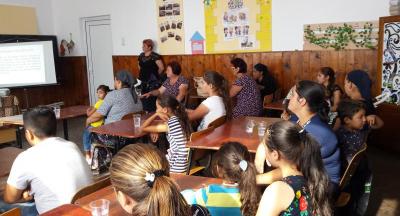Ramnicelu
*Disclaimer: The information and views set out in this page do not necessarily reflect the official opinion of the Council of Europe and/or the European Commission. Neither the Council of Europe, the European Commission nor any person acting on their behalf may be held responsible for the use which may be made of the information contained therein.
Last update 11/10/2016
Râmnicelu is situated in the North-Eastern part of Buzău County in Romania and is roughly 6 km from Râmnicu Sărat, a municipality that is also a part of the ROMACT Programme. It is composed of four small localities: Râmnicelu (administrative centre), Ştiubei, Colibaşi and Fotin. According to the latest census figures, out of the total population of 4,789 people living in Râmnicelu, 1,879 declared themselves to be ethnic Roma. Râmnicelu has a total of 1,313 households, around 370 of those are inhabited by Roma citizens. Like other municipalities in Romania, the number of Roma actually living in the municipality is likely to be much higher than the census figures indicate. Local unofficial estimates believe the Roma population to be more like 2,200, which would bring the community to represent 50% of the total population of the municipality. The majority of the community are Kalderash Roma, who tend to lead less traditional ways of life when compared to other Roma groups, though they do continue to preserve their Romani language.
The selling of fruits and vegetables is one of the main economic activities of the general population in the municipality, and the City Hall recorded 104 licenced citizens within the Roma community as fruit and vegetable vendors. Other members of the Roma community choose to look for job opportunities abroad, mainly in Germany, England and Spain - a trend mostly explained by the lack of job opportunities within and around Râmnicelu.
Within the Roma community there is a high birth rate which exceeds the capacity of local services in terms of health services and education. There is a particularly high demand for general practitioners for the Roma community, forcing many citizens in Râmnicelu to head to the nearest city to seek emergency care (Râmnicu Sărat) because of the insufficient general services in their area (1 doctor for 1,500 adults and children on average). Within the community there is also one health mediator and two community nurses.
In Râmnicelu there are 5 schools and 5 kindergartens, Roma children on the school registers show a low attendance rate to these schools. We have identified that one of the main reasons many Roma families in Romania depend on selling fruit and vegetables across the country to make a living is poor educational achievement, a side effect of this practice is that parents often have to leave their children in the care of relatives when they are away and, often, children accompany parents on their travels. There is a similar pattern found in Roma families who choose to migrate to other countries. There are two school mediators in the municipality and a total of 690 students.
In terms of housing and infrastructure, between 2010-2016, 53 plots were allocated to young families in the municipality, these plots included in the Emplacement Plan of Râmnicelu municipality and the intention is to continue a policy of housing Roma residents in the new neighbourhood with other Roma community members. In this residential area there are utilities with roads and water system provided by the local administration, the only remaining challenge to solve is connecting the neighbourhood to the electricity grid. Only 60% of Roma population have property documents for their houses and plots. The houses are built from reinforced concrete, metal, wood, stone, and burnt bricks. Households tend to be tightly packed with little or no space for yards.
The ROMACT Process
- With the Mayor’s signature on the Letter of Commitment in late 2015, Râmnicelu joined the ROMACT programme. The Local Plan of Action for Roma was adapted to include priorities which were defined by the Roma community, these priorites were approved by the Local Council on 31 March 2016. The LAP was annexed to the Local Development Startegy for the period 2014-2020 of the municipality.
The Community Action Group (CAG) in Ramnicelu defined the following priorities for their community:
| Short-term priorities | Objective 1 | Objective 2 | Objective 3 | Objective 4 |
|---|---|---|---|---|
| Health | Renovate and equip a medical centre for the Roma community | Employment of 1(one) doctor and 2 (two) medical assistants | ||
| Education | Reconstruction of Secondary Schools No. 1 and 2 | Providing auxiliary materials and equipment in schools | ”After School” Programs | |
| Housing | Address the issue of lack of ownership documents | |||
| Infrastructure | Extending the natural gas network | Rehabilitation of the local playground | Rehabilitation of 1 (one) sports centre | |
| Employment | Organise vocational training |
To respond common needs of Roma and non-Roma communities in Ramnicelu, local authorities have already initiated two infrastructure projects: “Rehabilitation of the water supplying system in Ramnicelu Village “ and “Sewerage system and filtering plants of the villages Ramnicelu and Stiubei. These projects were developed through the National Local Development Plan, which is coordinated by the Ministry of Regional Development and Public Administration of Romania.
Together with the ROMACT expert and in consultation with the CAG, local authorities are exploring funding opportunities and will rely on the expertise provided by ROMACT to build applications for projects.
Among some of the short-term issues identified by the CAG that are already addressed is the organisation of vaccination campaign among the Roma community between 30 August - 3 September 2016, where more than 50 infants were identified as needing vaccination. More on this story in this article.
Later in September 2016, an additional campaign was organised for awareness raising on reproductive health and risks related to early marriages.
- The Municipality benefited of ROMACT expertise for the following project:
Inclusive education, OPHC 6.3, School for everybody
Status: rejected

